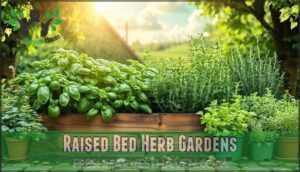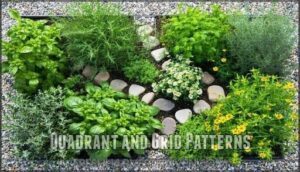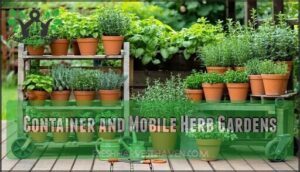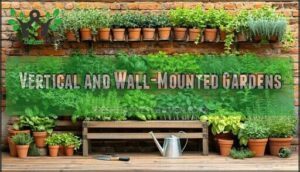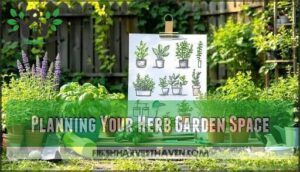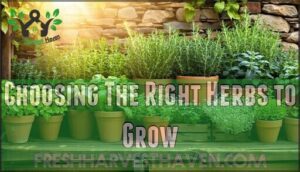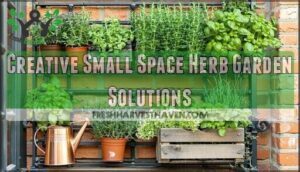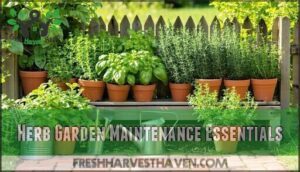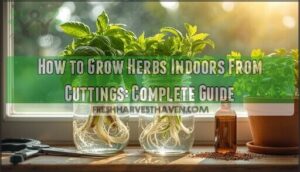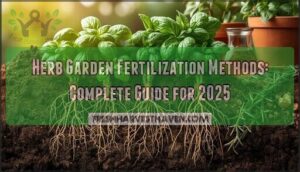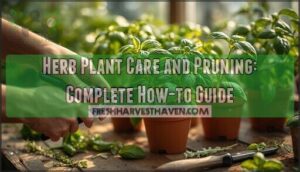This site is supported by our readers. We may earn a commission, at no cost to you, if you purchase through links.
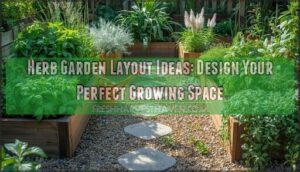
The truth is, a smart herb garden layout isn’t about following rigid rules; it’s about breaking free from guesswork and designing a space that actually works with your habits, your climate, and the way you cook.
Whether you’re working with a sprawling backyard or a fire escape barely wide enough for two containers, the right layout transforms random plants into a thriving, accessible system that keeps fresh flavor within arm’s reach all season long.
Table Of Contents
- Key Takeaways
- Best Herb Garden Layout Ideas
- Planning Your Herb Garden Space
- Choosing The Right Herbs to Grow
- Creative Small Space Herb Garden Solutions
- Herb Garden Maintenance Essentials
- Designing for Beauty and Functionality
- Frequently Asked Questions (FAQs)
- How to design a herb garden?
- What is the best layout for herb gardens?
- How to create an outdoor herb garden?
- What are the different types of herb garden designs?
- What is the best design for a raised herb garden?
- How do you decorate a garden with herbs?
- What is the best arrangement for an herb garden?
- What herbs should not be planted together?
- What are the best herbs to plant together?
- What month should you start an herb garden?
- Conclusion
Key Takeaways
- Smart herb garden layouts prioritize accessibility and workflow over aesthetics alone—placing your most-used culinary herbs within arm’s reach of the kitchen eliminates the friction that kills daily harvesting habits.
- Your growing space dictates the solution, not the other way around—raised beds solve drainage and back pain, containers enable mobility and microclimates, vertical systems reclaim square footage, and woodland designs exploit shade instead of fighting it.
- Successful herb selection balances perennials that return without replanting, evergreens that anchor year-round structure, and strategic annuals that deliver peak flavor when you actually need it in the kitchen.
- Maintenance becomes effortless when you design with intention—grouping herbs by water needs, pruning for bushiness rather than size control, and positioning tallest plants where they won’t shade out your workhorses transforms garden care from guesswork into rhythm.
Best Herb Garden Layout Ideas
Your herb garden’s layout isn’t just about cramming plants into dirt—it’s about creating a system that actually works for your space and lifestyle. Whether you’re dealing with a sprawling backyard or a cramped balcony, the right design makes all the difference between a thriving garden and a frustrating mess.
Let’s look at five proven layouts that give you the freedom to grow exactly what you want, exactly where you want it.
Raised Bed Herb Gardens
Raised beds might just be the smartest move for your herb garden. They solve drainage headaches, keep your back happy during harvest, and let you control soil quality from day one.
Build them with cedar, stone, or recycled materials to match your aesthetic, and size them so you can reach the center without stepping in.
Pack them with loamy, well-draining soil, plant your culinary herbs close together, and watch your garden design come alive.
Quadrant and Grid Patterns
If you want that classic European kitchen garden vibe—the kind where every herb has its place and the whole thing feels intentionally composed—a quadrant or grid layout gives you structure without stuffing you into a box. Divide your space into four equal sections with pathways between them, and suddenly you’ve got garden design principles working for you.
- Organize by type: Group culinary herbs in one quadrant, medicinals in another, keeping your harvest strategy sharp
- Plant perennials at the edges: Rosemary, sage, and thyme anchor the corners while annuals rotate through the center
- Use paths for access: Gravel, stone, or mulch walkways keep your boots clean and plants untrampled
- Balance height and spread: Taller herbs like dill go center-back, sprawlers like oregano fill front corners for visual harmony
Container and Mobile Herb Gardens
Containers break you free from fixed ground beds—roll your herbs into sun, tuck them under cover before frost, or stage them wherever you actually cook instead of hiking across the yard with scissors.
Mobile planters and self-watering pots make container gardening foolproof, while herb towers stack your small herb garden vertically.
Mix sizes—terracotta for Mediterranean herbs, glazed ceramics for moisture-lovers—and suddenly your portable garden becomes both space saver and design statement.
Vertical and Wall-Mounted Gardens
When floor space runs out, wall-mounted planters and living herb walls let you grow upward—turning fences, balcony rails, and bare brick into productive vertical real estate that doesn’t steal an inch from your patio or walkway.
Vertical gardens using mounted shelves or pocket systems transform urban greens into space savers, while trellis-backed container gardening lets climbers like oregano cascade downward.
It’s herb garden planning that defies gravity—reclaim your square footage without sacrificing your harvest.
Woodland and Shaded Herb Gardens
Not every herb demands blazing sunshine—shade-loving varieties like sweet woodruff, lemon balm, and wild ginger thrive under dappled canopy light, letting you carve out a woodland herb retreat where most gardeners see only darkness.
Woodland garden design turns forest floor plants into working kitchen gardens:
- Layer shade tolerant herbs beneath trees
- Mimic natural wild herb cultivation patterns
- Use mulch to retain moisture
- Plant in curved, informal clusters
- Embrace sustainable gardening with native varieties
Your herb garden doesn’t need full sun—just smart garden planning.
Planning Your Herb Garden Space
Before you break ground on your herb garden, you need to scope out your space like a designer mapping a canvas. The right spot can mean the difference between thriving herbs and a frustrating flop, so take time to assess what you’re working with.
Here are the four key factors you’ll want to nail down:
Assessing Sunlight and Microclimates
Before you dig in or drop a single seed, you need to read your garden like a landscape designer reads a site—because sunshine isn’t evenly distributed, and those sneaky microclimates can make or break your herb collection.
Track sunlight patterns throughout the day to identify which zones get that golden 6-8 hours most herbs crave. Check soil temperature and light intensity in different spots—south-facing walls radiate heat, while shaded corners stay cooler.
These microclimate zones are your secret weapon for strategic herb garden planning and sustainable gardening success.
Measuring and Mapping Your Area
Grab a tape measure and sketch pad—because even a 12-square-foot plot needs precision if you want every herb to thrive without turning into a tangled jungle. Area Assessment starts with Yard Measurement—capture actual dimensions, then mark boundaries and note obstacles.
Your garden map becomes the blueprint for dividing up space wisely, letting you work through design principles before breaking ground. This planning stage turns guesswork into a confident layout.
Ensuring Accessibility and Kitchen Proximity
Your best herbs won’t do you much good if you’re trudging through mud or squeezing past thorny rosemary every time you need a sprig of thyme for dinner. Kitchen Placement should prioritize Garden Accessibility—think clear paths and waist-high reach.
Proximity Planning puts Culinary Herbs where you’ll actually use them, making Kitchen Herbs part of your cooking flow. Smart Herb Selection and Space Optimization mean your Herb Garden Design works with you, not against you.
Evaluating Soil and Drainage Conditions
Soil testing reveals what your herbs really need before you plant a single seed. Most culinary herbs thrive in soil pH between 6.0 and 7.5, but clay-heavy ground or a high water table can sabotage even the best herb garden design.
Check your drainage systems—standing water for more than 24 hours can cut productivity in half. Smart irrigation management and sustainable gardening practices start with knowing your soil, transforming organic gardening from guesswork into precision herb gardening.
Understanding your soil test report is essential for creating an ideal environment for your herbs to grow.
Choosing The Right Herbs to Grow
Your herb selection will make or break your garden’s success, so you need to choose plants that match your goals and growing conditions.
Mix culinary herbs you’ll actually use, a few reliable perennials, and maybe one or two specialty plants—this combo keeps your garden producing year after year with minimal replanting.
Let’s look at what actually works for your specific conditions.
Top Culinary Herbs for Beginners
If you’re just starting out, you’ll want to focus on the twelve kitchen herbs that practically grow themselves and deliver knockout flavor every single time you snip a stem. These culinary herbs form your rebellion against bland cooking and grocery store markups:
- Basil – sweet, peppery punch for summer dishes
- Rosemary – woody backbone for roasted everything
- Thyme – earthy workhorse that pairs with anything
- Parsley – fresh, bright finish you’ll grab daily
- Mint – cooling contrast that spreads like wildfire
Evergreen, Perennial, and Annual Options
Once you’ve locked in your go-to herbs, it’s time to break them into camps—evergreen, perennial, and annual—so your herb garden design practically runs itself.
Evergreens like rosemary, sage, and thyme stay green all year and anchor your culinary herbs collection through winter.
Perennials such as chives, tarragon, and mint vanish in cold months but bounce back every spring without replanting, slashing your garden renewal workload.
Annuals—basil, cilantro, dill—deliver fast flavor but demand yearly planting; stagger them every few weeks for nonstop harvests and total control over your kitchen supply.
Understanding the difference between annual vs perennial herbs is essential for a thriving herb garden.
Herbs for Pollinators and Medicinal Use
Beyond flavor and texture, some herbs double as pollinator magnets and medicinal plants, transforming your herb garden design into a living pharmacy and bee-friendly refuge. Lavender pulls over 40 bee species and blooms for 12 weeks straight, while bee balm’s thymol content soothes colds and draws three hummingbird visits per hour.
Anise hyssop fights respiratory congestion and viral flare-ups, and fennel hosts 50 swallowtail larvae per season—proof that culinary herb gardening and herb ecology can coexist.
Plant these organic herbs near seating only if you’re comfortable sharing space with pollinators, or cluster medicinal herbs and pollinator herbs farther out for herbal remedies without the buzz.
Climate and Growing Zone Considerations
Pollinator herbs don’t care about your zone—but they won’t survive your winter. USDA hardiness zones map frost tolerance, so mint and chives crush Zones 3–4, while rosemary demands Zone 8 or warmer.
Zone mapping shifts northward 30 miles per decade, rewriting herb garden design rules. Heat tolerance matters too—Seattle’s humid Zone 9a drowns Mediterranean sage, while Houston’s dry 9a bakes it perfectly.
Microclimate effects like wind and shade trump zone labels, so climate adaptation means watching your actual conditions, not just frost protection dates, for growing herbs that thrive in organic gardening setups with real gardening tips.
Creative Small Space Herb Garden Solutions
You don’t need a sprawling backyard to grow fresh herbs—just a little creativity and smart use of vertical space. When square footage is tight, thinking upward and repurposing everyday items can transform even the smallest balcony or patio into a thriving herb haven.
I’ve got a few clever tricks up my sleeve that’ll help you squeeze every last inch out of your space—and still end up with gorgeous, productive plants.
Repurposed Shelves and Step Ladders
That old wooden step ladder gathering dust in your garage could become the centerpiece of your most charming herb garden yet. Position it near a sunny wall, and you’ve got instant tiers for an herb garden design that breaks all the boring rules. Each step holds a pot—rosemary up top, trailing thyme cascading down—turning vertical space into your own edible rebellion.
- Shelf gardens create organized zones for culinary herbs while maximizing space optimization in tight quarters
- Ladder displays offer natural drainage as water flows down, preventing root rot in your repurposed planters
- Vertical arrangements bring herbs to eye level, making harvesting easier and garden design ideas more accessible
- Mix pot sizes on different tiers to accommodate sprawling basil or compact chives, following smart gardening tips for varied growth patterns
Vertical Trellis and Rail Planters
Balcony railings and bare fences are underutilized goldmines waiting to hold your next wave of fresh herbs without claiming a single inch of floor space. Mount rail planters along your balcony edge and suddenly you’ve got a culinary herb garden that doesn’t compete with your seating area.
Trellis systems transform garden walls into vertical gardens—perfect for climbing oregano or sprawling thyme—while space savers like hanging brackets keep your herb garden plants thriving where traditional beds can’t reach.
Stackable and Tiered Container Ideas
Stacking containers upward doesn’t just save space—it turns vertical real estate into a productive herb tower that pulls double duty as garden art.
Tiered planters and modular designs let you arrange culinary herbs like basil, parsley, and thyme in layers that catch different light angles, while stackable pots create herb garden designs that adapt as your collection grows—no ground footprint required.
Using Decorative and Unusual Pots
Quirky containers—think vintage teapots, weathered boots, or reclaimed colanders—break up the visual monotony of standard plastic nursery pots and inject personality into your herb garden layout without sacrificing function.
Pot selection becomes part of your garden design strategy when you match planter materials to your space’s vibe—galvanized buckets for farmhouse charm, ceramic bowls for Mediterranean flair.
Just punch drainage holes, choose container styles that fit your culinary herb garden needs, and watch mismatched vessels transform into herb displays that actually tell a story.
Herb Garden Maintenance Essentials
Getting your herb garden planted is just the beginning—keeping it thriving takes a bit of know-how. The good news is that herbs are pretty forgiving once you understand their basic needs.
A few key practices will keep your garden flourishing from spring through fall.
Watering, Pruning, and Harvesting Tips
Your herbs won’t thrive on autopilot—they need the right rhythm of water, strategic snips, and timely harvests to keep delivering those kitchen-ready flavors all season long.
Check soil moisture before watering—stick your finger an inch deep and water only when it feels dry. Sharp pruning tools make clean cuts that encourage bushier growth, while morning harvest timing captures peak oils.
These organic gardening techniques and smart herb plant care keep your herb garden design productive without waste, letting water conservation and proper herb planting work in your favor.
Organic Fertilizing and Mulching
Feed your soil right, and it’ll feed your herbs better than any synthetic shortcut ever could. Layer natural mulch like straw or shredded leaves to lock in moisture and suppress weeds, then work in compost tea or aged organic matter every few weeks.
Soil amendments and green manure boost nutrients without chemicals, keeping your herb garden design aligned with sustainable living and smart organic gardening techniques that actually deliver flavor.
Pest Control and Disease Prevention
Keep pests at bay without poison by mixing Integrated Strategies that actually work. Scatter marigolds and chives to repel aphids, then release ladybugs for Biological Controls that cut infestations by 80%.
Weekly neem oil treatments and baking soda sprays tackle mites and mildew, while copper tape blocks slugs cold.
Disease Prevention starts with smart spacing and base watering—prune infected leaves fast to stop spread before it steals your harvest.
Expanding Your Herb Garden Over Time
Once your herbs are thriving and pest-free, it’s time to multiply your success through division, seed starts, and strategic additions that match your growing confidence.
- Root cuttings from rosemary and thyme in water, then transplant for instant Garden Expansion without nursery runs
- Divide mature clumps of chives and oregano every two years for Space Optimization that fills gaps fast
- Save seeds from cilantro and dill for Seasonal Planning that keeps your Herb Garden producing year-round
- Add one specialty herb monthly—lemon verbena, lovage—to master Herb Propagation while refining your Garden Design instincts
Designing for Beauty and Functionality
Your herb garden shouldn’t just be a functional workspace—it should be a place you actually want to spend time in.
How you arrange plants, combine their visual elements, and structure the space itself determines whether your garden becomes a daily joy or just another chore.
Here’s how to create an herb garden that feeds both your kitchen and your soul.
Arranging Herbs for Easy Harvest
Smart placement means the difference between snipping fresh basil in your pajamas and trudging across the yard in the rain—so let’s position your most-used herbs where you’ll actually grab them.
Place your culinary herb garden workhorses—basil, parsley, cilantro—front and center for easy garden accessibility. Taller perennials like rosemary and sage belong in back rows, preventing shade battles while keeping harvest timing simple.
Smart herb grouping by use frequency transforms herb garden planning from guesswork into guerrilla efficiency—your kitchen herbs become an extension of your counter, not a chore.
Combining Colors, Textures, and Fragrance
Beyond function lies the real magic—layering silver-green sage against dark purple basil, feathery dill next to sturdy oregano, and clouds of lavender fragrance drifting past mint’s sharp coolness turns your herb patch into a sensory theater.
These texture and scent combinations make for stunning garden designs:
- Pair velvety lamb’s ear with glossy-leafed basil for tactile drama that invites touching
- Cluster white-flowering thyme near purple chive blooms for color schemes that pop
- Position fragrant herbs like rosemary at garden edges where brushing past releases their oils
- Mix spiky textures (rosemary, lavender) with soft billowy forms (parsley, cilantro) for visual rhythm
- Plant mint and lemon balm where their competing scents create complex aromatic layers
Your culinary herb garden becomes a sensory experience—not just ingredient storage.
Incorporating Paths and Decorative Elements
Paths aren’t just for getting from point A to point B—they frame your herb beds, slow you down enough to notice that first oregano bloom, and give the whole garden a sense of intentionality that separates "patch of plants" from "designed space."
Gravel, stepping stones, or reclaimed brick bring pathway materials into play alongside decorative stones marking transitions, while garden ornaments and landscape lighting transform your herb garden design from utilitarian to landscape design showcase.
This approach offers garden design inspiration that’s pure rebellion against boring rows.
Creating a Relaxing and Enjoyable Space
The real magic happens when your herb garden becomes less about ticking boxes and more about carving out a pocket of peace you’ll actually want to linger in.
Position seating where you can breathe in that sensory experience—fragrant rosemary, bee-humming lavender—and let natural aesthetics guide your garden ambiance.
Mindful gardening meets ecofriendly rebellion when your culinary herb garden doubles as your personal peaceful retreat.
Frequently Asked Questions (FAQs)
How to design a herb garden?
Picture yourself wandering through fragrant rows of fresh basil and rosemary just steps from your back door.
Designing an herb garden starts with space optimization—assess your sunlight, choose multi-use herbs that match your climate, then map out a layout strategy balancing garden aesthetics with accessibility for easy harvesting.
What is the best layout for herb gardens?
Layout flexibility wins—raised beds and quadrant patterns increase space optimization while keeping culinary herbs grouped by use.
Container gardens adapt anywhere, letting you customize garden aesthetics and shift herb grouping as your needs evolve.
How to create an outdoor herb garden?
Creating an outdoor herb garden starts with choosing a sunny spot near your kitchen. Most culinary herbs crave six to eight hours of direct light.
Prepare well-draining soil, sketch out garden layouts that suit your outdoor spaces, and select herbs based on your climate and cooking habits.
What are the different types of herb garden designs?
You’ll find everything from structured Formal Gardens with clipped hedges to whimsical Cottage Gardens bursting with blooms.
Herb Spirals optimize vertical space, while Keyhole Beds bring efficiency to your Culinary Herb Garden.
Micro Gardens transform tiny spots into productive zones—your Landscape Design, your rules.
What is the best design for a raised herb garden?
Throw out that old cookie-cutter approach—your raised herb garden layout thrives when you blend practical Raised Beds with smart Herb Selection and killer Garden Aesthetics, prioritizing Soil Quality and Space Optimization for your dream Culinary Herb Garden.
How do you decorate a garden with herbs?
Decorating with herbs means blending fragrance gardens and sensory landscapes into your landscape design.
Layer different heights, textures, and bloom colors while using herb planters as garden art.
Choose herb garden themes—Mediterranean culinary herb garden or cottage-style—to guide your aesthetic choices and create functional beauty.
What is the best arrangement for an herb garden?
Your best bet? Place herbs you use most near the kitchen door, group perennials together for easy maintenance, and arrange taller plants like rosemary behind shorter ones like thyme—this culinary herb garden design optimizes space while keeping everything within arm’s reach.
What herbs should not be planted together?
Don’t let bad herb pairing throw your garden into chaos. Mint spreads aggressively and chokes neighbors, while fennel stunts most culinary herbs nearby.
Avoid planting dill with cilantro—they cross-pollinate and ruin flavors.
Match growth patterns and space requirements for harmony.
What are the best herbs to plant together?
Group herbs with similar water needs—drought-tolerant Mediterranean herbs like rosemary, thyme, and oregano thrive together, while moisture-loving basil, parsley, and cilantro make natural companions.
Clustering by growth patterns and fragrance creates seamless harvest zones.
What month should you start an herb garden?
Jump into herb garden planning between March and May in most climates—after frost danger passes but while soil’s still workable.
Climate considerations and plant hardiness zones dictate your timing, though growing herbs indoors from seed can start earlier.
Conclusion
Your herb garden layout isn’t just a blueprint—it’s your declaration of independence from mediocre grocery store sprigs. The best designs don’t follow cookie-cutter templates; they bend space, light, and timing to your advantage.
Your herb garden layout is your declaration of independence from mediocre grocery store sprigs
Whether you’ve mapped out raised beds or stacked containers on a balcony, you’ve built something that answers to no one but you. Now step outside, run your fingers through that thyme, and taste what happens when herb garden layout ideas meet real intention.
- https://www.motherearthnews.com/organic-gardening/garden-designs-kitchen-herbs-zmaz06onzraw/
- https://www.the-herb-guide.com/herb-garden-design.html
- https://www.jekkas.com/blogs/jekkas-blog/jekkas-small-culinary-herb-garden-designs
- https://www.gardenary.com/blog/how-to-grow-herbs-in-a-small-space
- https://www.hgtv.com/outdoors/flowers-and-plants/herbs/herb-garden-design-ideas-pictures

